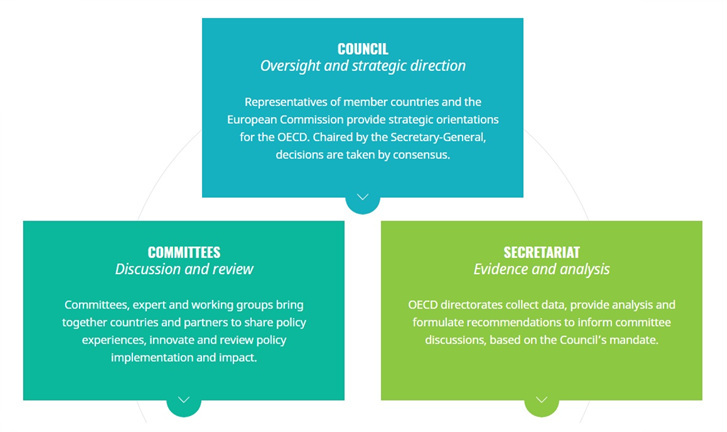The OECD’s Structure
How is the OECD structured and managed? The organisation consists of essentially three poles: its governing Council, committees of specialists, and the Secretariat.

Council
The OECD Council is the organisation’s overarching decision-making body. It is composed of ambassadors from Member countries and the European Commission, and is chaired by the Secretary-General. It meets regularly to discuss key work of the Organisation, share concerns and take decisions by consensus. Once a year, the OECD Council meets for the Ministerial Council Meeting, which brings together heads of government, economy, trade and foreign ministers from Member countries to monitor and set priorities for our work, discuss the global economic and trade context, and delve further into issues such as the budget or the accession process.
Committees
The OECD works through more than 300 committees, expert and working groups which cover almost all areas of policy making. Our committees propose solutions, assess data and policy successes, and review policy actions among Member countries. They cover the same issue areas as government ministries, such as education, finance, trade, environment, development, and liaise with country-level experts. Committee participants come from Member and partner countries, and represent state bodies, academia, business and civil society. Around 40,000 people take part in these meetings every year. Some discussions can evolve into negotiations in which all OECD countries define and follow common global rules.
Secretariat
The OECD Secretariat carries out the work of the OECD. It is led by the Secretary-General and composed of directorates and divisions that work with policy makers and shapers in each country, providing insights and expertise to help guide policy making based on evidence in close coordination with committees. Directorates report to the Secretary-General. The 3,900 employees of the Secretariat include economists, lawyers, scientists, political analysts, sociologists, digital experts, statisticians and communication professionals. In addition to its Headquarters in Paris, France, the OECD also has centres in Berlin, Mexico, Tokyo and Washington D.C., which are part of the OECD’s public affairs and communications team.
source : OECD, https://www.oecd.org/about/structure/

